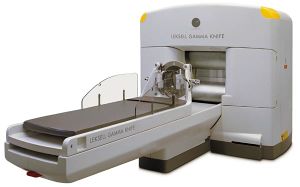Gamma knife radiosurgery
Contents
Definition:
This procedure involves fixing a rigid stereotactic frame to the patient's head, which acts as a reference, defining the volume it encloses in a set of X, Y, and Z co ordinates. This is combined with radiological images can be used to target tumors and pathologies involving the skull base. Radiation is then delivered using gamma chambers. The fundamental difference between radiosurgery and irradiation is that in radiosurgery it is delivered as a single high dose rather than a fractionated course as seen in irradiation.
Differences between irradiation and radiosurgery
| Irradiation | Radiosurgery |
|---|---|
| Delivered in fractionated doses | Delivered as a single high dose |
| Need not use precise targetting | Should be precisely targetted |
| Gamma knife is not needed | Gamma knife is needed. It contains an array of 201 cobalt sources |
| Pathological tissue should be more radiosensitive than normal surrounding tissue | Since the beam is highly focussed the radiosensitivity of the tumor mass is not an issue. |
The dose of radiation used in stereotactic radiosurgery has a steep shoulder (rapid fall off), and because of this feature it spares the surrounding tissues.
Procedure:
The procedure perse has four steps.
First step: A stereotactic frame is fitted to the head under local anesthesia.
Second step: Radiological images, generally MRI are acquired.
Third step: The scanned images are processed using Gamma plan which is a radiosurgery planning software. This helps in the calculation of cumulative radiodose.
Final step: Is treatment delivery. In this step the patient lies on a couch of the gamma knife,the stereotactic frame is attached to a collimator helmet. Radiation is delivered only when the outer and inner collimators are aligned. The delivery of radiation itself is silent and painless. No general anesthesia is needed and the patient can be managed as if he has undergone a daycare procedure.
Role of stereotactic radiosurgery in the management of acoustic schwannoma:
Radiosurgery is very useful in the management of acoustic schwannoma of less than 3 cm in diameter. This procedure is minimally invasive with negligible facial / trigeminal nerve morbidity. Hearing is also preserved in these patients. NF 2 tumors respond less well to all treatment modalities including radiosurgery.
Role of radiosurgery in the management of skull base meningiomas:
Radiosurgery can be used as an adjunct to open surgery in the management of skull base meningiomas. It is not commonly used as a primary treatment modality because meningiomas are slow growing tumors and by the time they become symptomatic they would have enlarged to a size considerably more than 3 cms which is the treatment limit for radiosurgery.
Role of radiosurgery in glomus jugulare tumors:
The thrombo - obliterative effect of radiosurgery is really useful in the management of vascular tumors like glomus jugulare.
Limitations of stereotactic radiosurgery:
1. The machine itself is designed for cranial disease and hence is limited for intracranial and skull base lesions.
2. The design limitations of the knife makes it really unsuitable for use in lesions of neck.
3. Ideal targets are usually less than 3 cms
Role of radiosurgery in otolaryngology:
1. Stereotactic radiosurgery has been found to be useful in the management of vestibular schwannomas.
2. It can be used to treat skull base tumors like meningiomas.
3. Glomus jugulare tumors can be ideally managed by radiosurgery
Advantages of radiosurgery:
1. It is minimally invasive.
2. Cranial nerves are generally spared leading to preservation of hearing and trigeminal / facial nerve functions
3. No anesthesia is needed
4. Risk of malignancy is really low
Concerns expressed about radiosurgery:
1. Long term follow up is needed.
2. Remote possibility of radiation induced malignancy
3. Causes peritumoral scarring making future surgeries really difficult
